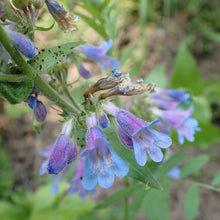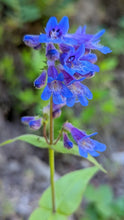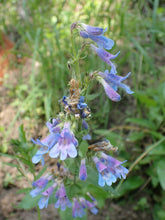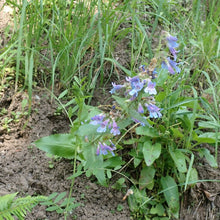
Penstemon ovatus
Broad-leaved Penstemon (Penstemon ovatus) is a long-lived, versatile wildflower that appeals to pollinators and gardeners alike. In spring, it emerges with a rosette of glossy, deep green, strongly saw-toothed foliage. By early summer, tall flower stalks sport whirls of tubular, blueish purple flowers that attract hummingbirds as well as scores of native bees, butterflies and flower flies. Its drought-tolerance and overall adaptability to a wide range of garden conditions also makes it a resilient choice for garden habitats.
- Plant type/canopy layer: deciduous, perennial, herbaceous plant
- Size at maturity: 8"-36" tall, equally wide
- Light requirements: part sun/part shade
- Moisture requirements: moist soil
- Bloom time: May - July (May - June in the Portland Metro area)
- Growth rate/ease: medium growth rate, moderately easy to grow
- Wildlife support: flowers attract and provide nectar for hummingbirds, adult butterflies, bees, syrphid flies and other native insect pollinators; seeds are eaten by songbirds; dense foliage provides cover and nesting areas for arthropods and tiny soil-dwelling creatures; overall plant attracts and supports beneficial and other pest eating insects and is a caterpillar host plant and larval food source for native butterflies and moths
- Native habitat/range: grows in shady places on mossy rocks and outcrops, at low to mid elevations, with a relatively scattered distribution throughout the western Columbia Gorge and parts of the Willamette Valley, as well as northern areas of the Olympic peninsula and southern British Columbia. Portland Plant List - yes.
- Special features & uses: pollinator and hummingbird favorite; drought tolerant; landscape uses include pollinator gardens and rock gardens
Gardening with Broad-leaved Penstemon: If you’ve tried (and likely killed) other species of native penstemon, you may be on the brink of writing-off this genus altogether, until you meet broad-leaved penstemon. This species is significant;y more yard-friendly than its cousins, adapting to most any light situation, except deep shade and 100% full sun. Providing 6-8 hrs of sun per day, especially earlier in the day, will result in abundant blooms, without frying it. As far as soil, it will thrive in moist, sandy or loamy soils that are both well-draining and nutrient rich (think decomposing organic matter and/or low-nitrogen compost). But overall it is less-fussy and doesn’t require the lightning-fast drainage and perfect soil composition that other native penstemons demand. Be sure to water regularly but not excessively during the first one to two summers. After that, they should only need deep, infrequent water on dry sites.
Mulching can help retain moisture and suppress weeds - however it might also smother the hideouts of the amazing ground-nesting critters that utilize this habitat power-house. In Sparrowhawk’s garden, we generally opt for more natural forms of “mulch”, like planting densely, leaving all leaves and other plant material that fall in-place and breaking up any plant parts that get cut back and leaving them as close to where they grew as possible.
Planting several in a group or drift will help pollinators find and utilize this plant, plus it’ll look better and suppress weeds. Space plants 12”-24” apart, and set back from paths and edges, since it becomes quite wide by the end of the growing season. Over time, it will become woody and shrub-like but responds nicely to being occasionally cut back if the form becomes too unruly for your personal taste. They may self-sow gently as well.
Companion plants (info courtesy of Real Gardens Grow Natives): Try it at home in sunnier areas with serviceberry (Amelanchier alnifolia), red-twig dogwood (Cornus sericea), blue elderberry (Sambucus nigra ssp. caerulea), large leaf lupine (Lupinus polyphyllus), Douglas aster (Symphyotrichum subspicatum), Oregon iris (Iris tenax), camas (Camassia spp.), and blue-eyed grass (Sisyrinchium spp.). Or in shadier areas with Cascade Oregon grape (Mahonia nervosa), western sword fern (Polystichum munitum), goatsbeard (Aruncus dioicus), fairy bells or fairy lanterns (Prosartes spp.), false solomon’s seal (Maianthemum racemosa), Oregon oxalis (Oxalis oregana), wild ginger (Asarum caudatum).
Photo Credits 1, 3, 4 (flowers close, flower stalk, habit): © giantcicada, some rights reserved (CC-BY)
Photo Credit 2 (stalk with blue flowers): © John A Haskins, some rights reserved (CC-BY)







